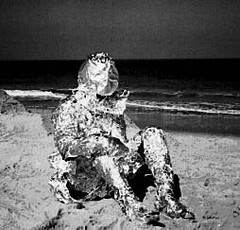Most of us don’t have a basic knowledge of labor history, much less the plight of illegal immigrant laborers in Twenty-first Century America

Part III
Illegal Immigration Versus Legal Immigration
Immigration is the history of the United States of America. Native Americans are the only true Americans. The rest of us are immigrants. Wave after wave came to the Americas beginning with the 17th century, a total of 18 million immigrants from all over the world up to the year 2000. The first wave included African, English, Scotch-Irish, Scottish, and German immigrants. During the early 19th century immigrants came from the German Empire, Ireland, Britain, Austro-Hungarian Empire, Canada, China and Africa. Later in the 19th and 20th centuries millions more immigrants came from Southern and Eastern Europe, many Spanish speaking nations of the world, including Spain itself, the orient, and India . My own family, on my mother’s side came to Philadelphia in 1683. The most recent members of our family to immigrate came in 1907.
Restriction of immigration began in the 1880’s but became significant in the 1920’s and with that came an increase in illegal immigration. Thus illegal immigration of oriental, Latino, and others of various ethnic origins is a direct result of our attempt to limit the number of immigrants entering the United States during the Twentieth Century. As such, the entrance of these people under incredably harsh conditions is a tribute to the quality of life, belief system, ideals, and economic prosperity of the United States of America during that same period.
Xenophobia
How then is it possible that a nation of immigrants are so fearful of new immigrants as to make it illegal for them to enter in the first place, and in the second, to deny that they serve a useful function in our society?
19th century fears of llegal immigration were similar to those that 21st Century Americans have of illegal immigration. Donna Gabaccia director of University of Minnesota Immigration History Center states that these fears included the following.
1. Southern and Eastern Europeans would take American’s jobs.
2. Europeans would out produce Americans already here and thus gain dominance over the culture.
3. European immigrants would depress wages.
4. Southern and Eastern Europeans would bring dangerous and radical ideas, not those of Islam, rather anarchism, socialism, and communist internationalism.*
My personal experience here in South Florida is that people of Latin origins do everyone’s gardening, including city, county, and state. The men do much of the highway and other infrastructure work. They also do the heavy grunt work that us Northern European former immigrant types won’t do in building and construction. Men and Women serve in restaurants on kitchen staffs everywhere. They work in sweat shops to make the clothing we wear and they make it less expensive to buy. If we deny them and say that they take our jobs, we are telling tales to ourselves. I personally do not want to dig holes in someone’s garden, nor along a highway in the hot blazing sun 8 hours a day. I do not want to be the guy, weeding, edging, and mulching, and zapping garden plants with bug spray, unless it be in my own garden.
Quite frankly I’m tired of the ugly Curmudgeon American, including Lou Dobbs complaining about this divisive issue. Yes, by all means, tighten the borders by enforcing existing laws George W. Bush! Yes, do give the 11 million existing illegal immigrants the opportunity to become American citizens, even if you do make them indentured servants for the next 6 to 7 years. Yes, stop moaning and groaning, and demand that your government serve the people again, instead of itself.
While you’re at it, you might want to check out the following.
1. the University of Minnesota Center of Immigration History
2. The Statue of Libery – Ellis Island Foundation
Sources
United Mine Workers,” http://en.wikipedia.org/wiki/United_Mine_Workers. Modified 23:48, 15 March 2006. Viewed 10:48 EST, Tuesday, March 28, 2006.
The Social Studies Help Center. “The Labor Union Movement in America,” http://www.socialstudieshelp.com/Eco_Unionization.htm. © 2001-2006. Viewed 10:51 EST, Tuesday, March 28, 2006.
The National Learning Curve. “Trade Unions,” http://www.spartacus.schoolnet.co.uk/USAtu.htm. Viewed 9:44 AM EDT, Tuesday, April 4, 2006.
Labor Arts. “About Us,” http://www.laborarts.org/about/. ©, Labor Arts Inc. Viewed 10:13 AM EST, Friday March 31, 2006.
Montgomery County Public Schools (Montgomery, Maryland). “Social Studies: An Apprenticeship in Liberty.” http://mcps.k12.md.us/curriculum/socialstd/curriculum/ushist.html. © 2003. Viewed 10:18 AM, Friday, March 31, 2006.
Public Schools of North Carolina, Standard Courses of Study, Social Studies :: 2003:: Eleventh Grade Social Studies. http://www.ncpublicschools.org/curriculum/socialstudies/scos/2003-04/067eleventhgrade. No copyright. Viewed 10:30 AM EST, Friday
“University of Minnesota Moment, Friday, 1/27/06.” University of Minnesota, Center of Immigration History, University of Minnesota Website, http://www.ihrc.umn.edu/. Viewed Friday, April 7, 2006, 10:08 AM EDT.(*The 4 points listed above are Donna Gabaccia's, Director of the Center of Immigratin History at the University of Minnesota.)
“The Peopling of America: a timeline…” The Statue of Liberty – Ellis Island Foundation. http://webcenter.ellisisland.netscape.com/immexp/wseix_4_3.asp. © 2000, The Stature of Liberty – Ellis Island Foundation. Viewed Friday, April 7, 2006, 10:21 AM EDT.


0 Comments:
Post a Comment
<< Home